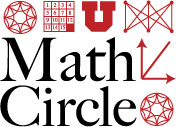2013-2014
|
Oct 23 (First Meeting) |
| Peter Trapa Bulgarian Solitaire
|
The following game was made popular by Martin Gardner in the early 1980's. Begin with a fixed number of pennies and arrange them into piles in any way you like. A move in the game consists of taking one penny from each pile and forming a new pile with them. Keep repeating the process until you encounter an arrangment of (unordered) piles that you have seen before. For example, if you started with piles of size (2,2,1,1), the first move would have you to piles of size (4,1,1), the next to (3,3), the next to (2,2,2), the next to (3,1,1,1), the next to (4,2), the next to (3,2,1), and then finally to (3,2,1) again when the game stops because you have seen (3,2,1) twice. A moment's thought shows that the game always stops. There are, after all, only a finite number of configurations of piles. If the number of moves exceeds the number of possible configurations, the pigeon hole principle guarantees that you must have already met the same configuration of piles somewhere along the way. There are a few obvious questions: What at the possible ending configurations of piles? How many moves does it take to get to them? What if we changed the game and kept track of the order of the piles? One nice approach to these questions is based on a way to visualize the move operation. I learned this is in an article by Griggs and Ho titled "The Cycling of Partitions and Compositions under Repeated Shifts", which is a little dense and abstract, but might make for the starting point of a nice independent study project. (Let me know if you're interested.) November 6th |
| Bulgarian Solitaire Continued -- and other related games
|
This week we want to prove (using the visual interpretation of the Bulgarian solitaire move) the main conjecture we formulated last time. Write n uniquely as a sum of a triangular "core" plus a deviation from being triangular: n = 1+2+...+ k + t (where t is greater than or equatl to 0 and less than or equal to k). The conjecture is as follows: the only ending configurations are of the form (1,2,...,k) with 1's added to t distinct piles, and all of these configurations are indeed ending configurations. For example, if n is itself triangular (and so t=0), the only ending configuration is (1,2,...,k). We then want to find the maximum number of moves required (at least if t is 0) to land on one of these ending configurations. Finally, we will move on to related games of this nature, including a problem from an IMO in the 1960s. November 20th |
| More Bulgarian solitaire, related games, and contest questions
|
Last time we mostly went in a different direction and tried to determine the configurations which could only arise as starting confirgurations; that is, the ones which do not come from a move applied to another configuration. One of the participants suggested calling such configurations a Garden of Eden (or GE for short), following terminology that arises in a similar situation in the Game of Life. We proved that a initial configuration is a GE if and only if the number of piles is greater than equal or equal to two plus the number of objects in the largest pile. It turns out that it is possible to write down all GEs, but this is a little bit tricky. You can find more details here: An Exact Enumeration of Garden of Eden Partitions by B. Hopkins and J. Sellers.
This time, tacked away from Bulgarian Solitaire into other
seemingly unrelated questions that can be answered by the kind of
analysis we developed for Bulgarian Solitaire. The main problem we discussed
(but did not solve) is discussed in notes here. (Spoiler
alert: don't read past page 10 until we meet next time.)
December 4 |
| Candy Sharing Games (continued)
|
January 29 |
| Games of Criss-Cross
|
We started with the game of criss-cross (nicely explained in these notes by Sam Vandervelde). We ended by posing related questions and devising related games on more exotic surfaces (like tori). We'll continue that thread next time.
March 5 |
| Criss-Cross (continued)
|
We'll pick up the discussion of playing the game of criss-cross game on other interesting surfaces (like the torus and Klein Bottle).
March 19 |
| Mad Hatters
|
We worked through a lot of the problems in the excellent article A Dozen Hat Problems by Ezra Brown and James Tanton.
April 16 |
| More Mad Hatters
|
This time we selected one of the problems from last time, and took a deeper look at generalizations. We loosely followed the notes here by Brody Dylan Johnson.
May 14th |
| Sam
Vandervelde, The
Game of ESPionage
|
Please join us for a special end-of-year Math Circle session with renowned mathematician and problem solver, Sam Vandervelde.
|
||
- campus: a to z index
- map
- directory
- calendar


